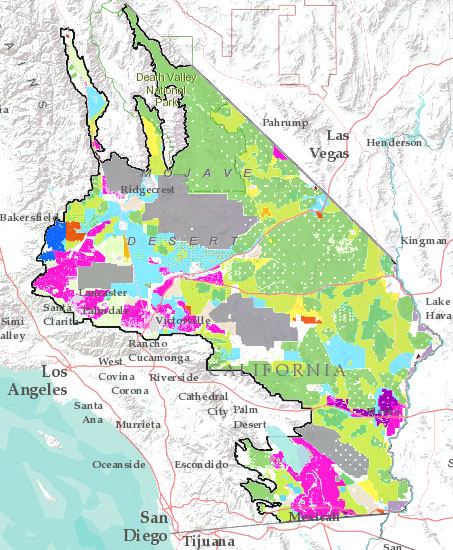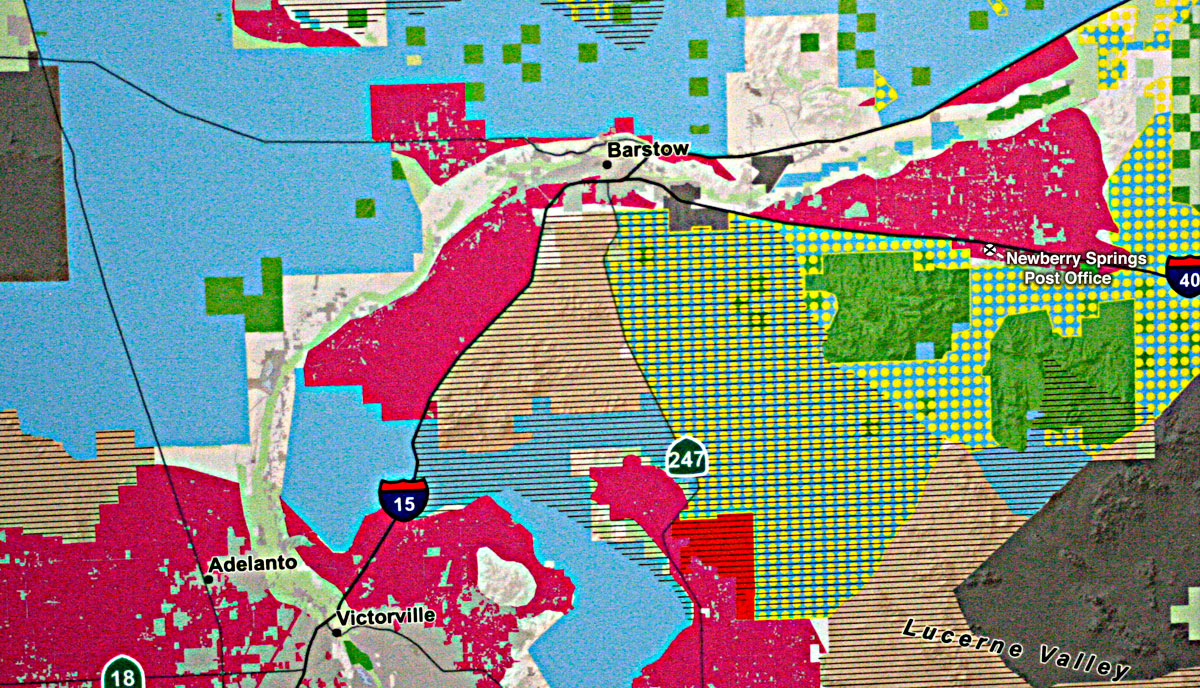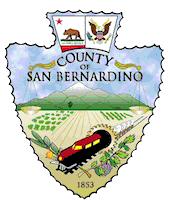|
County Supervisor Robert Lovingood, center, rubs shoulders
following a meeting with Karen Douglas of the California Energy Commission
and Jim Kenna, California Director of the Bureau of Land Management. It would
appear that they had a luncheon meeting by what looks to be a take-home
doggy bag box in Lovingood's hands.
|
|
Lovingood's words came late.
|
December 2, 2014
Robert Lovingood has recently given out a press release
stating his happiness over the current demise of the Silurian Valley Solar Project.
This is a huge 2.5 square-mile proposed solar project that has been planned 10-miles north of
Baker on the road to Death Valley. Jim Kenna, pictured above, decided to turn the proposal
down on behalf of the BLM.
Lovingood's voice against the project would have received better
public reception if he had used his elected position to have joined his constitutents
in prominently speaking out publicly against the project. After the Bureau of Land
Management has axed the project, its easy to politically stand against it for
the publicity.
"We need to be very careful in locating renewable
energy projects," Lovingood states in his press release. "We have listened
to our constituents that these projects should first be located on already-disturbed
land rather than on beautiful, untouched desert near the gateway to Death Valley."
Who is Supervisor Lovingood listening to?
The question arises as to which constitutents within
his High Desert district Lovingood is listening to. The Desert Renewable Energy
Conservation Project (DRECP), and the San Bernardino County Partnership
for Renewable Energy & Conservation (SPARC) program, have both held a
series of public scoping meetings that have made one point very clear from the
public's responses, Lovingood's constitutents do not want any more large scale
solar projects being built in the High Desert.
It is not a matter of where more should be built, it is a
matter that San Bernardino county has already been approved for far more than its
fair share of the state's industrial sized alternative energy facilities.
It becomes a constitutional issue of the rural minority being unfairly overly burdened
and exploited by the urban majority consumers who don't want industrial sized facilities
being built and negatively impacting their own back yards.
Photovoltaic technology advancing at iPhone warp speeds.
The renewable energy technology is advancing so
fast that the county's precious viewscapes and ecosystems are being destroyed by the
construction of government-subsidized relics. In 2014, the huge Ivanpah solar
arrays and towers went into power production. When proposed, the design was
trumpeted as the future. Now, after being built, the facility is underperforming and
solar industry publications say that it is the last of its kind that will be built.
Profit and millions in tax subsidized dollars are being lost on power production that isn't
being achieved and far more natural gas than planned is being consumed by the plant to heat
boilers to make up the difference.
Environmental impacts of the Ivanpah project are now being
found to be far more than originally forecast by the optimistic developers and accepted by
the wishful governing authorities being pressured by the Obama Administration.
The only public element pushing for placement of such facilities
on disturbed land are the desert conservationists; many of whom do not live in the desert's
disturbed areas where their homes could be adversely impacted.
Framework for massive high speed solar development.
The seven county DRECP, comprising of 22.5-million acres,
11.9-million of which is in San Bernardino county,
 is now centralizing its concentration upon industrial sized developments upon
disturbed land, such as the Mojave Valley (Newberry Springs-Daggett-Yermo).
is now centralizing its concentration upon industrial sized developments upon
disturbed land, such as the Mojave Valley (Newberry Springs-Daggett-Yermo).
The preferred targeted areas are shown on the adjacent map in purple.
In the close-up map of the Mojave Valley region shown below, the preferred areas are shown in red.

Lovingood's remarks came on the heels of BLM California
Director Jim Kenna turning down the proposal by a subsidiary of Iberdrola Renewables,
LLC, for a 200 megawatt photovoltaic solar project on 1,616 acres along Highway 127.
A proposed wind project remains in the planning phase.
In making its determination on the Silurian Valley
project, the BLM analyzed environmental data in addition to gathering information
from the public and local, state, federal and tribal governments.
The initial review and analysis indicated that the impacts to the Silurian
Valley, a largely undisturbed valley that supports wildlife, an important
piece of the Old Spanish National Historic Trail, and recreational and
scenic values, had too great of an impact on the resources.
The BLM concluded that these impacts likely could not be mitigated
and that the project would not be in the public interest.
The BLM has approved 18 solar, wind and geothermal
projects on public lands in California since 2010. The Silurian Valley
project is the first to be denied through the variance process.
The DRECP's current plan is to use private disturbed land.
The DRECP's preferred 'Alternative' scheme will hit
the High Desert's residents like a destructive tsunami. With such a
devastating impact forseeable, it is shocking how unaware the vast majority
of the High Desert's residents are. At the October 28, 2014 general
board meeting of the Newberry CSD, most of the board had no understanding
of the project nor knowledge of the project's 7-year planning.
Most are probably still in a complete fog of its significance.
The DRECP's preferred plan targets previously disturbed land,
most all of which is privately owned land that is under county regulatory control.
Therefore, the San Bernardino County Partnership for Renewable Energy & Conservation
(SPARC) program, that is developing the future county regulations on alternative energy,
is paramount to controlling a massive DRECP overreach upon High Desert residential
land and property investments.
Unfortunately, the SPARC development project is being
fully funded by a
 grant from the California Energy Commission. The county's corrupt Land
Use Services Department has hired consulting firms to develop the SPARC plan
by seeking the public's input. The results have been alarming, because
dispite many public hearings being symbolically held, and the public being
informed that they are important and are being listened to, the direction of
the plan has not been emphasizing the public's No Build desire.
grant from the California Energy Commission. The county's corrupt Land
Use Services Department has hired consulting firms to develop the SPARC plan
by seeking the public's input. The results have been alarming, because
dispite many public hearings being symbolically held, and the public being
informed that they are important and are being listened to, the direction of
the plan has not been emphasizing the public's No Build desire.
The SPARC development plan
has been centered upon the public's responses to prearranged questions directed
by the hired consultants, who have been minimizing the public's No Build
desire (Perspective 1), except for distributed-type (rooftop) installations
(referred to in the SPARC reports as accessory-scale distributed generation).
In short, the intermediate SPARC reports on public input
appear accurate for the data collected. But the method of collecting the
data, by prearranged questions that are slanted to guide the responses to yes-build
conclusions, is faulty.
Powerful pro-alternative energy players involved.
The California Energy Commission is promoting the
expansion of industrial alternative energy facilities throughout the state.
The Land Use Services has repeatedly demonstrated to be on the side of industrial sized
alternative energy development and its bias has been repeatedly demonstrated by its work
with the SPARC project.
As a result, High Desert residents are being left to depend upon
a SPARC project that is consultant driven; and is being prepared on the behalf
of the California Energy Commission, under a grant being overseen by a pro-development
county department.
With the exception of public comments, the SPARC process is
failing to include public groups, such as the Alliance for Desert Preservation, the
California Desert Coalition, and the Mojave Communities Conservation Collaborative, with
direct participation within the SPARC exclusive development club. The DRECP has
special interest stakeholders involved, such as the Sierra Club for advisors. SPARC
appears to be driving its own predetermined agenda.
High Desert residents are being deceived.
The overwhelming strength of the public's desire for the No
Build alternative has not been genuinely reflected in the SPARC produced reports.
This, in part, is due to the No Build alternative not being given adequate recognition
and placement within the SPARC workbooks; nor discussions. The workbooks are given to the
public during the workshops like a questionaire. Although the public may verbally express
or write-in their desire for No Build, the emphasis in the data collection appears
to be given to the checked-off responses that can be tallied from the questionaires.
The public has verbally expressed a clear preference for what is
going to be the alternative energy wave of the future, that being distributed solar (rooftop)
installations. Not the federal government's subsidized industrial monsters that are
costing billions of dollars in transmission line costs alone.
The cost of the Coolwater-Lugo transmission line alone is expected
to add approximately $110-million per year onto Southern California Edison's
ratepayers' billing. Edison under California PUC tariffs get to keep just over 10% of
that for maintenance and management. As Southern California Edison (SCE) no longer produces
electricity, but only handles electric distribution and service, Edison is very dependent upon
new transmission lines (like Coolwater-Lugo) being built for a new income revenue stream.
If built, SCE gets paid whether the lines are ever used or not.
Supervisors Lovingood and Ramos appear to be the only line of
defense that could protect their constituents' home and community interests. Although
Lovingood has been favorably instrumental in defeating some inappropriate alternative energy
projects, he has failed to be consistant, voting in some other terrible stuff.
We need public crusaders. The question is whether
Supervisors Lovingood and Ramos are up to the challenge that the voters have trusted
them with.
|